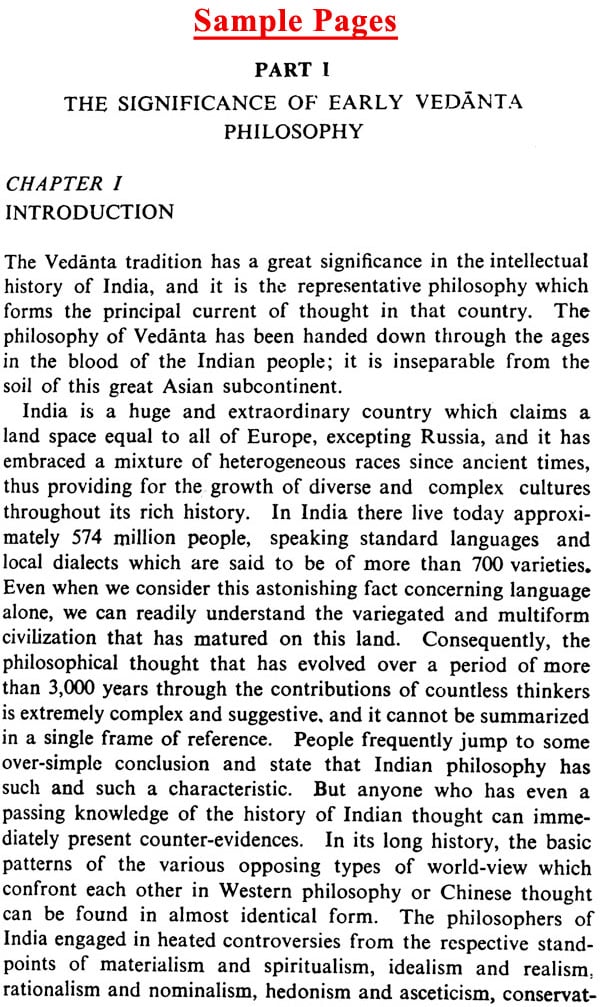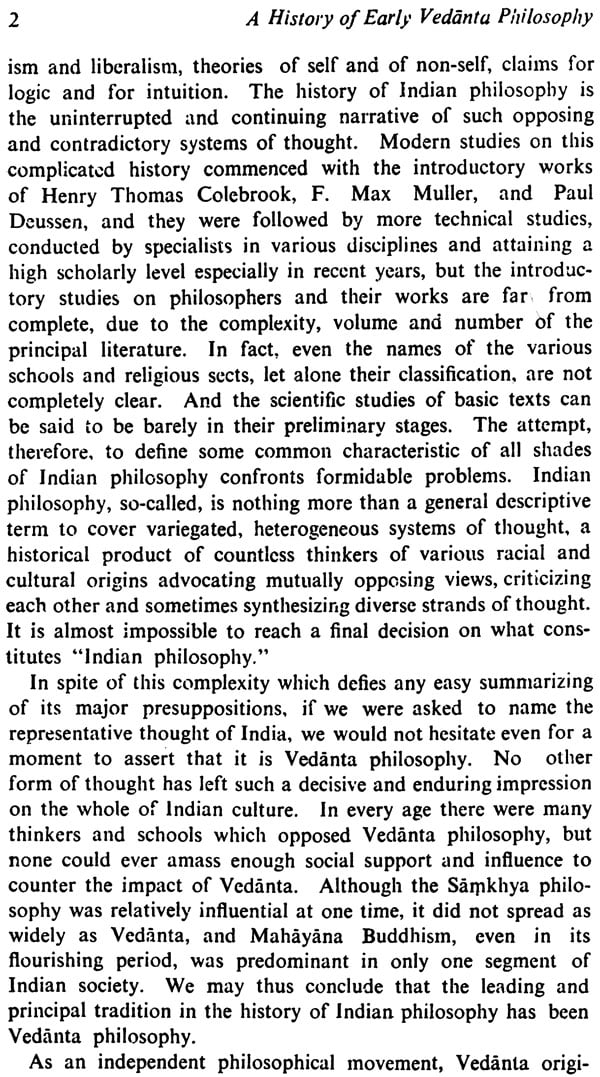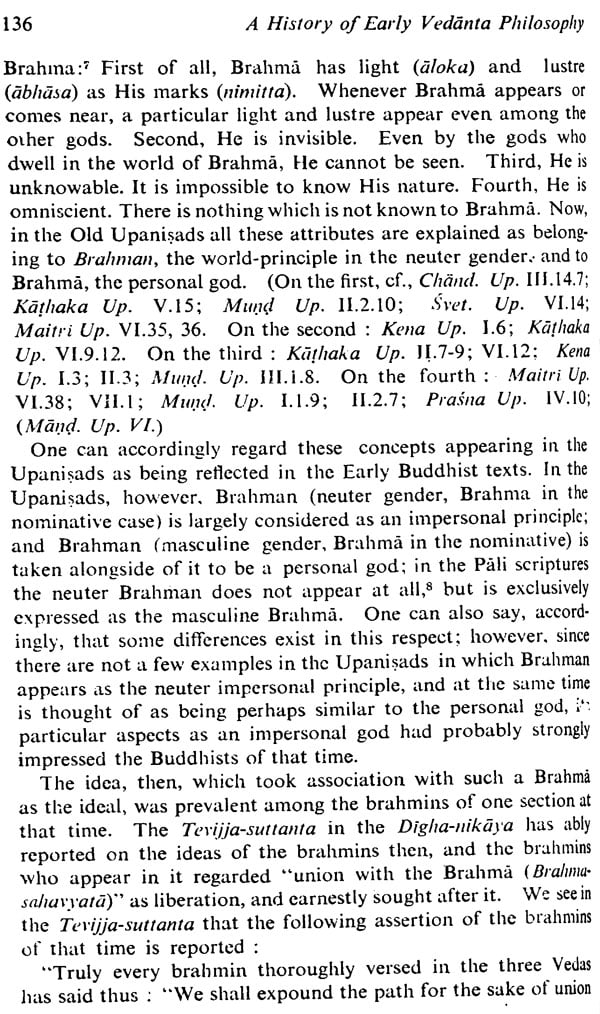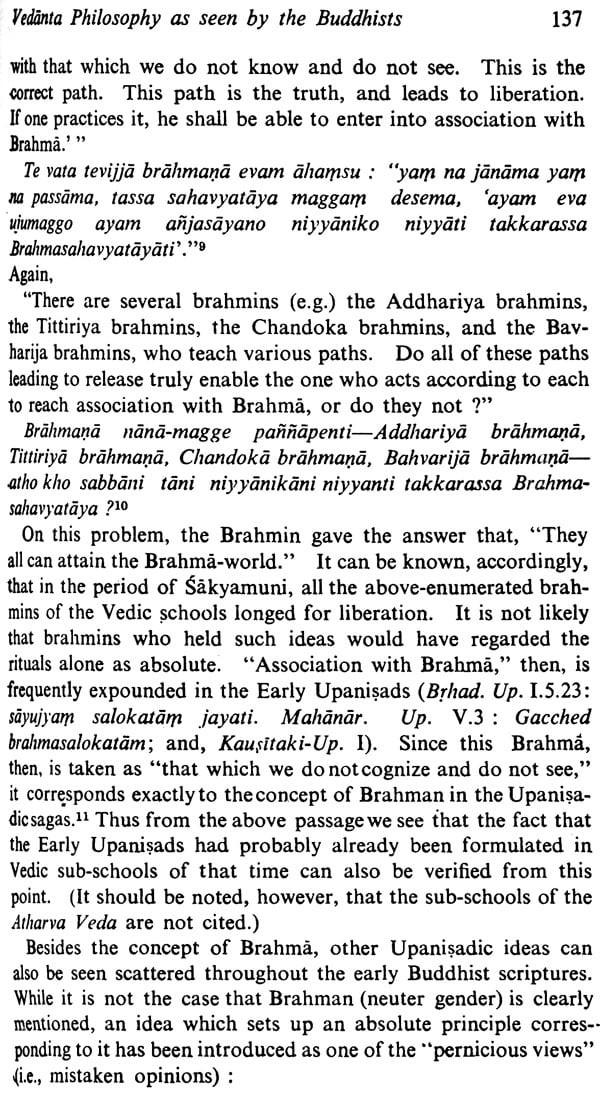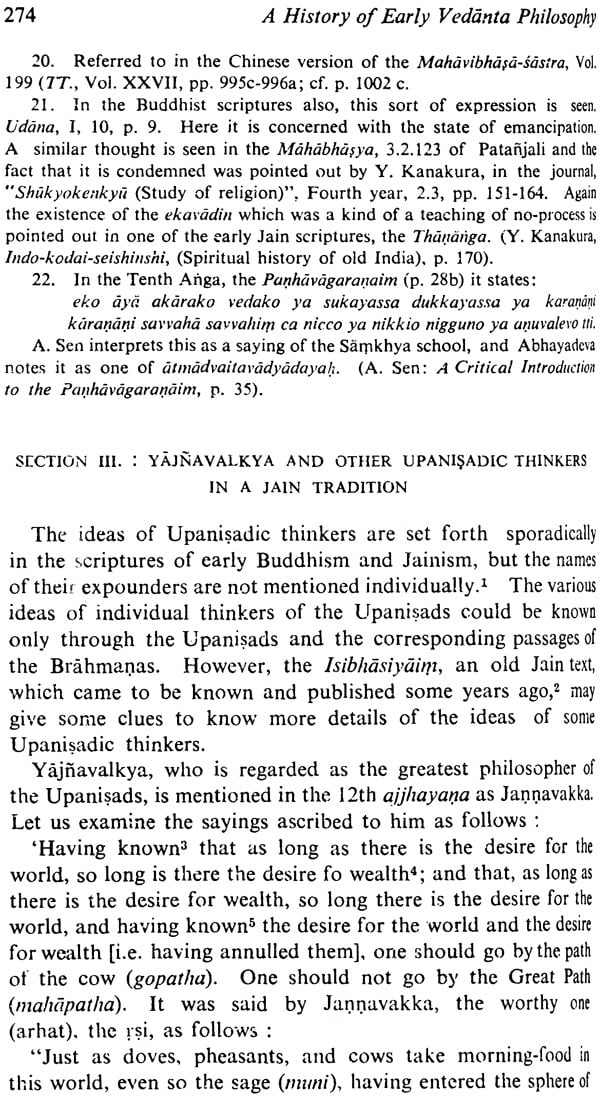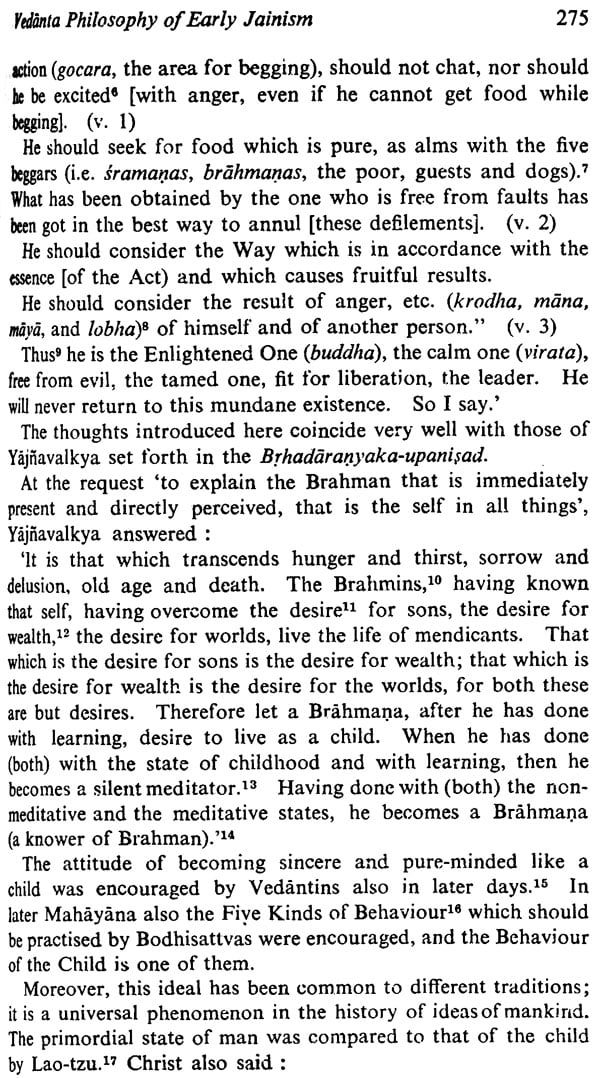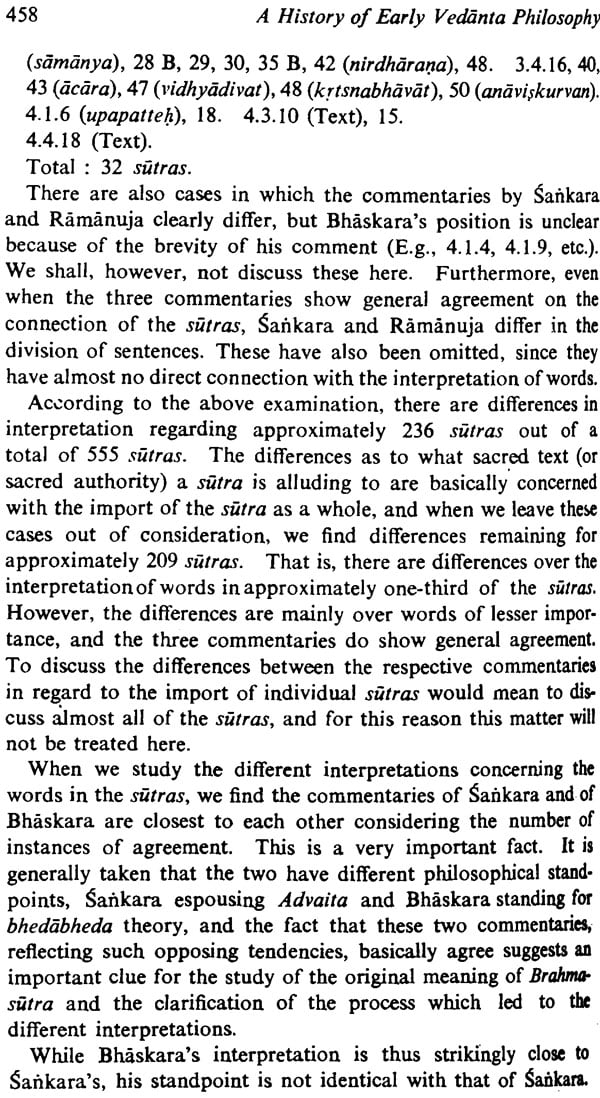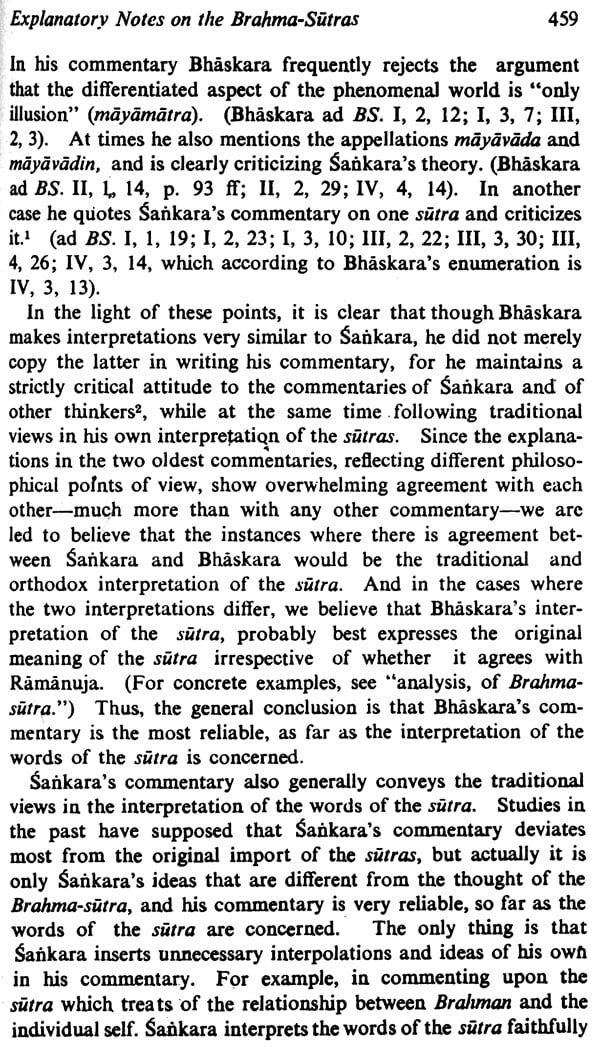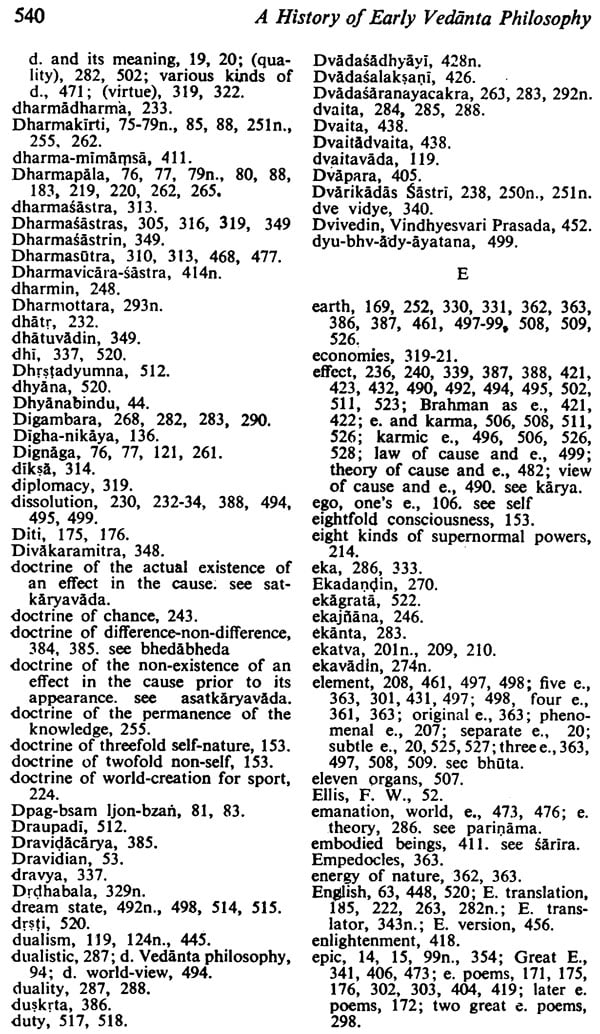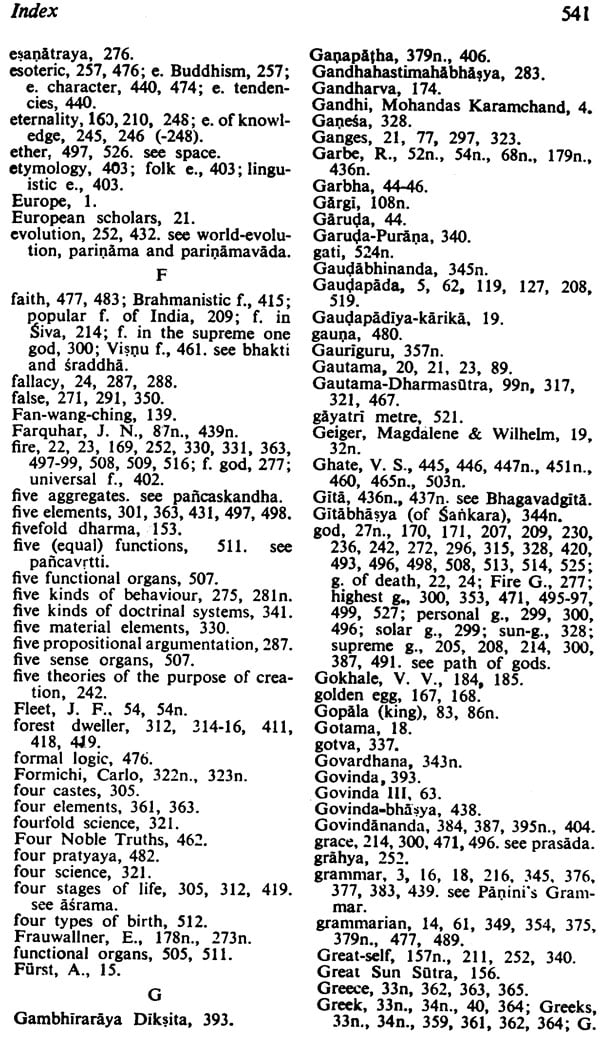
A History of Early Vedanta Philosophy - Part One
Book Specification
| Item Code: | IDE527 |
| Author: | Hajime Nakamura |
| Publisher: | Motilal Banarsidass Publishers Pvt. Ltd. |
| Language: | English |
| Edition: | 1990 |
| ISBN: | 9788120806511 |
| Pages: | 585 |
| Cover: | Hardcover |
| Other Details | 8.8" X 6.2" |
| Weight | 780 gm |
Book Description
From the Jacket:
The history of the Vedanta school is well known since the time of Sankaracarya on, and its prehistory before Sankara is quite obscure. However, from the time of compilation of major Upanisads to Sankara there is a period of thousand years, and the tradition of Upanisads was not lost; there appeared many philosophers and dogmaticians, although their thoughts are not clearly known.
The author has made clear the details of the pre-Sankara Vedanta philosophy, utilizing not only Sanskrit materials, but also Pali, Prakrit (Jain), as well as Tibetan and Chinese sources.
In this respect this is quite a unique work. For this work the author was awarded the Imperial Prize by the Academy of Japan.
Some sections of this work were already published in Indian as well as European and American journals in English. This work is a complete English translation of the entire book. The English translation was done with the financial aid by the Harvard-Yenching Institute, and the final touch was given by Mr. Trevor Leggett, the British writer, who is well-versed in Sanskrit as well as in Japanese.
About the Author:
Professor Hajime Nakamura, D.Litt. (University of Tokyo), Honorary D.Litt. (Government of India and Nehru University) is a distinguished scholar of international repute. As a Chairman of the Department of Indian Philosophy and Literature, Director of the Eastern Institute, Tokyo and a member of several Research Institutes in India and other countries he has a brilliant career. He was awarded the honorary degree of Vidya-vacaspati by the President of the Republic of India, Dr. S. Radhakrishnan. He was awarded the honorary doctorate by the University of Delhi and Kuppu-Swami Research Institute, Madras. He was also awarded the honorary degree of Deshikottama by Visvabharati University, Shantiniketana. He was Visiting Professor at Harvard University, Stanford University, University of Hawaii, State University of New York.
He was Professor of Indian and Buddhist Philosophy a the University of Tokyo for thirty years. Since his retirement he has been conducting the Eastern Institute, Inc., as the Founder-Director. He is now Professor Emeritus of University of Tokyo. He is an Honorary Fellow of the Royal Asiatic Society of Great Britain and Ireland and a Corresponding Member of the Austrian Academy of Science, Vienna.
He is a versatile and striking genius. He has splendid achievement in the literary field too. Among his greatest production may be ranked History of Vedanta, 4 Volumes (in Japanese), Early Buddhism, 5 Volumes (in Japanese), Japan and Indian Asia (in English) and History of the Development of Japanese Thoughts, 2 Volumes.
| Preface | vii | |||||
| Abbreviations
| xiii | |||||
| | ||||||
| Chapter I | Introduction | 1 | ||||
| Chapter II | The Chronological Division of Early Vedanta Introduction | 9 | ||||
| Part I | The Period of the Composition of the Upanisads | |||||
| Section I | The Old Upanisads | 10 | ||||
| Sub-Section I | The Relative Date Order of the Old Upanisads | 10 | ||||
| Sub-Section II | Criteria for Dating | 13 | ||||
| I | Linguistic Investigation | 13 | ||||
| II | Relation with Other Schools of Thought | 17 | ||||
| III | The Chronological Relation of the Early and Middle Period Upanisads | 35 | ||||
| IV | Conclusion | 42 | ||||
| Section II | The Dates of the Formulation of the New Upanisads | 43 | ||||
| Section III | The Eraly Limit of the Early Vedanta School | 45 | ||||
| Part II | The Dates of Sankara and Contemporary Philosophers | 48 | ||||
| A. | A Critique of Past Arguments on the Dates of Sankara | 48 | ||||
| Section I | The Traditional Theory of the Sankara School | 48 | ||||
| Section II | The Arguments for Sankara's Dates based upon the Keralotpatti | 52 | ||||
| Section III | The Argument for Sankara's Dates Based upon the Legends of Nepal | 54 | ||||
| Section IV | Theories which Try to Trace Back rom the Date of the Samksepa-Sariraka | 55 | ||||
| Section V | The Arguments for Sankara's Dates Based upon his Relation with Hinduism | 57 | ||||
| Section VI | The Argument for the Dates of Sankara Based upon the Proper Nouns in the Brahma-sutra-bhasya | 59 | ||||
| B. | The Determination of the Dates of Sankara and Contemporary Philosopher | 65 | ||||
| Section I | The Relation between Sankara and the Philosophers after him | 65 | ||||
| (1) | The Relation between Sankara and the Dates of Vacaspatimisra and Bhaskara | 65 | ||||
| (2) | The Relation between the Dates of Suresvara and Sankara | 72 | ||||
| Section II | The Relation between Sankara and the Philosophers Prior to him | 75 | ||||
| (1) | The Relation between Sankara and Dharmakirti | 75 | ||||
| (2) | The Dates of Kumarila in Conjunction with those of Bhartrharti, Santaraksita, Kamalasila, and Mandanamisra | 79 | ||||
| (3) | The Determination of Sankara's Dates | 87 | ||||
| Section III | Concluding Remarks | 88 | ||||
| Chapter III | The Significance of the Vedanta Philosophy | 90 | ||||
| Section I | Definition of "Vedanta" | 90 | ||||
| Section II | Characteristics of the Vedanta | 101 | ||||
| Section III | The Circumstances of the Foundation of the Vedanta School | 108 | ||||
| Section IV | Other Names of the Vedanta School | 117 | ||||
| Section V | The Beginnings of the Vedanta School
| 126 | ||||
| | ||||||
| Introduction
| 129 | |||||
| Chapter IV | Vedanta Philosophy as Seen by the Buddhists | 131 | ||||
| Section I | Introduction | 131 | ||||
| Section II | Early Buddhism and Upanisadic Thought | 133 | ||||
| Section III | Sectarian Buddhism and the Upanisads | 140 | ||||
| Section IV | The Mahayana Sutras and Vedanta Thought | 152 | ||||
| Section V | The Early Madhyamikas and the Upanisads | 158 | ||||
| 1. | Nagarjuna and the Upanisads | 158 | ||||
| 2. | Orthodox Brahmanical Thought Mentioned in Aryadeva's Sastra on Heretic and Hinayanist Nirvana | 165 | ||||
| Section VI | References to Upanisadic Ideas in the early Yogacara School Maitreya-natha and Vasubandhu | 180 | ||||
| Section VII | The Vedanta Philosophy Known to Bhavya and Dharmapala | 182 | ||||
| Sub-Section 1 | Introduction | 182 | ||||
| Sub-Section 2 | The Vedanta Chapter of Bhavya's Madhyamaka-hrdaya | 184 | ||||
| Sub-Section 3 | The Vedanta as Presented by Bhavya in his Madhyamaka-hrdaya and Tarka-jvala | 206 | ||||
| Sub-Section 4 | The Vedanta Thought as Referred to in Other Texts of Bhavya | 217 | ||||
| Sub-Section 5 | The Vedanta Thought Mentioned by Dharmapala | 219 | ||||
| Section VIII | The Vedanta Philosophy Reported by Santaraksita and Kamalasila | 221 | ||||
| Introduction | 221 | |||||
| Sub-Section I | An Examination of Purusa (Purusa-pariksa) | 230 | ||||
| A. | Translation | |||||
| B. | Remarks | |||||
| Sub-Section II | An Examination of Atman falsely constructed by the Aupanisadas (Aupanisadakalpitatmapariksa) | 245 | ||||
| A. | Translation | |||||
| B. | Remarks | |||||
| Section IX | Vedanta Philosophy and Buddhism after Santaraksita and Kamalasila | 257 | ||||
| 1. | Remarks | 257 | ||||
| 2. | Bhaskara the Vedantin in Buddhist Literature | 260 | ||||
| Chapter V | Vedanta Philosophy as Seen from the Scriptures of Early Jainism | 266 | ||||
| Section I | Introduction | 266 | ||||
| Section II | Vedanta Thought Described in the early Jain Scriptures | 268 | ||||
| Section III | Yajnavalkya and Other Upanisadic Thinkers in a Jain Tradition | 274 | ||||
| Section IV | The Vedanta as Noticed in Mediaeval Jain Literature | 282 | ||||
| Section V | Conclusion | 294 | ||||
| Chapter VI | Vedanta as it Appears in the Orthodox Brahmanical Literature | 296 | ||||
| Section I | The Brahmin as Transmitter of Indian Culture | 296 | ||||
| Section II | Vedanta Philosophy in the Epic Poems | 298 | ||||
| Section III | Vedanta Thought in the Dharmasastras | 305 | ||||
| Section IV | Vedanta in the Arthasastra | 319 | ||||
| Section V | Works on Natural Science and the Connection with Vedanta | 323 | ||||
| Section VI | Vedanta Philosophy in Philosophical and Religious Works | 330 | ||||
| Section VII | Vednata in Purely Literary Works | 345 | ||||
| Chapter VII | (Supplement). Vedanta Thought Handed down by the Greeks
| 359 | ||||
| | ||||||
| Chapter VIII | The Character and Thought of the Scholars prior to the Brahma-sutra | 369 | ||||
| Section I | Karsnajini | 366 | ||||
| Section II | Kasakrtsna | 372 | ||||
| Section III | Atreya | 380 | ||||
| Section IV | Audulomi | 382 | ||||
| Section V | Asmarathya | 384 | ||||
| Section VI | Badari | 386 | ||||
| Section VII | Jaimini | 390 | ||||
| I. | His Works | 390 | ||||
| 1 | Mimamsa-sutra | 390 | ||||
| 2 | Devata-kanda and the Samkarsana-Kanda | 392 | ||||
| 3 | Sariraka-sutra | 396 | ||||
| II. | His Personality and Dates | 399 | ||||
| III. | His Vedanta Thought | 401 | ||||
| Section VIII | Badarayana | 404 | ||||
| Chapter IX | The Separation of the Two Mimamsas | 409 | ||||
| Section I | The Relation Between the Two Mimamsas | 409 | ||||
| Section II | The Ideological Confrontation of Jaimini and Badarayana
| 414 | ||||
| | ||||||
| Chapter X | Introduction | 425 | ||||
| Section I | Other Names of the Brahma-sutra | 425 | ||||
| Section II | The Circumstances under which the Brahma-sutra came into being | 429 | ||||
| Section III | The Date of the Compilation of the Brahma-sutra | 435 | ||||
| Section IV | Prestige of the Brahma-sutra is later Centuries | 438 | ||||
| Section V | The Style of the Brahma-sutra and the need for a Re-examination of the Original Meaning of the Sutras | 439 | ||||
| Chapter XI | Explanatory Notes on the Brahma-sutra | 448 | ||||
| (Appendix) Results of the Comparative Study of the Three Ancient Commentaries | 451 | |||||
| Section I | The Historico-Social Attitude of the Brahma-sutras | 470 | ||||
| Section II | Problem of Knowledge | 475 | ||||
| Section III | The Absolute and World-Creation | 484 | ||||
| (1) | Brahman in Itself | 484 | ||||
| (2) | Brahman as the World-Cause | 486 | ||||
| (3) | Rationality of World Emanation | 492 | ||||
| (4) | The Emanation and Dissolution of the World | 497 | ||||
| Section IV | The Individual Self | 500 | ||||
| (1) | The Relationship Between the individual Self and Brahman | 500 | ||||
| (2) | The Various Characteristics of the Individual Self | 504 | ||||
| (3) | The Structure of Individual Existence | 507 | ||||
| 1 | The Various organs | 507 | ||||
| 2 | Chief Vital Breath | 508 | ||||
| 3 | Body | 509 | ||||
| 4 | Conclusion | 511 | ||||
| (4) | Types of Individual Existences | 512 | ||||
| (5) | Consciousness | 514 | ||||
| Section V | Practical Affairs | 515 | ||||
| 1. | Practical Life | 515 | ||||
| 2. | Meditation | 519 | ||||
| Section VI | Transmigration and Release | 524 | ||||
| 1. | The Soul after Death | 524 | ||||
| 2. | The Realm of Spiritual Liberation | 529 | ||||
| Index | 533 | |||||
| Errata | 563 | |||||
